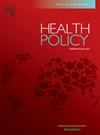The role of socio-economic determinants in the interregional allocation of healthcare resources: Some insights from the 2023 reform in the Italian NHS
IF 3.6
3区 医学
Q1 HEALTH CARE SCIENCES & SERVICES
引用次数: 0
Abstract
This paper discusses a reform recently implemented in the Italian National Health Service, aimed at adding some socio-economic indicators to the criteria adopted for allocating healthcare funding to Regions. The reform is based on international experience in healthcare financing in decentralized settings and provides a case study of special interest since Italy is a country with significant territorial disparities and severe budget constraints. The paper first discusses the long-standing debate between Italian Regions which led to the reform. Second, it reviews the main features of the reform which provides for the inclusion of socio-economic indicators via a simplified formula. Moreover, a possible revision of the reform is proposed, fully exploiting the information on the heterogeneity of health needs according to age and socio-economic indicators. By integrating the information on deprivation inside the risk adjustment mechanism, the weight of the different drivers is determined by the distribution of needs and not on a discretionary basis. Simulating the proposed revision suggests that more resources could be allocated to the Regions with higher levels of deprivation compared to a scenario that closely replicates the reform.
社会经济决定因素在医疗资源区域间分配中的作用:2023年意大利NHS改革的一些见解。
本文讨论了最近在意大利国家卫生局实施的一项改革,其目的是在向各地区分配医疗保健资金的标准中增加一些社会经济指标。这项改革是根据国际上在权力下放环境下医疗融资方面的经验进行的,并提供了一个特别有趣的案例研究,因为意大利是一个地域差异很大、预算限制严重的国家。本文首先讨论了导致改革的意大利地区之间长期存在的争论。第二,它审查了改革的主要特点,其中规定通过一个简化的公式列入社会经济指标。此外,还提议对改革进行可能的修订,充分利用关于不同年龄和社会经济指标的保健需求的异质性的信息。通过将关于剥夺的资料纳入风险调整机制,不同驱动因素的权重取决于需求的分配,而不是酌情决定。模拟拟议的修订表明,与完全复制改革的情景相比,可以将更多的资源分配给贫困程度较高的区域。
本文章由计算机程序翻译,如有差异,请以英文原文为准。
求助全文
约1分钟内获得全文
求助全文
来源期刊

Health Policy
医学-卫生保健
CiteScore
6.40
自引率
6.10%
发文量
157
审稿时长
3-8 weeks
期刊介绍:
Health Policy is intended to be a vehicle for the exploration and discussion of health policy and health system issues and is aimed in particular at enhancing communication between health policy and system researchers, legislators, decision-makers and professionals concerned with developing, implementing, and analysing health policy, health systems and health care reforms, primarily in high-income countries outside the U.S.A.
 求助内容:
求助内容: 应助结果提醒方式:
应助结果提醒方式:


